Grasping the Basics
So, imagine standing on one leg, balancing a cup of coffee on our heads, while wondering, 'Is it remotely possible that if push comes to shove, the police have the authority to shoot me 22 times?' A precarious query, wouldn’t you say? But hang tight, because we are going to dive headfirst into this complicated issue and navigate our way through the murky waters of police usage of force. Let’s start with the basics, which I believe is a good launching pad for any knotty topic.
Surely by now, we all acknowledge that the police are obligated to maintain law and order, a monumental task that requires a judicious blend of power and restraint. But the question hangs in the air - how much power is TOO much? When we talk about 'shooting', it becomes imperative to understand the backdrop against which these actions are sanctioned.
The cornerstone of any civilized society is a set of rules, regulations and statutes. We shall hence begin by shedding light on the legislation, namely the Fourth Amendment of the U.S Constitution. This piece of document neatly wraps up the standards regarding 'reasonable' use of force, which includes shooting. However, remember kids, 'reasonable' is by no means a numeric value that can be universally translated to '22’.
Interpreting 'Reasonable'
Now that we could see the constitutional scaffold of police power, let's climb a bit higher and explore the contents of 'reasonable' sealed in the Fourth Amendment. The term ‘reasonable’ is as slippery as a pair of banana peels. When we talk about reasonable force, it's like trying to hold onto a jellyfish with a fork. It's an ambiguous term open to a million interpretations, just like the ending of a Christopher Nolan movie.
The 1989 landmark case Graham v. Connor tidily presents the yardstick for measuring what constitutes 'reasonable' force. This case led to a universally accepted principle that a ‘reasonable’ use of force must be evaluated from the perspective of a rational officer on the scene, not with 20/20 hindsight. The most crucial factor? The 'severity of the crime at issue'. In other words, did you jaywalk or rob a bank?
While our coffee might now be lukewarm or downright cold, we now have a rough sketch of what 'reasonable' entails. So, let's move forward to understand more about the considerations that guide these life-or-death decisions. Keep reading. There's more ground to cover, and I promise it's worth your while.
Considerations Behind the Trigger
Let's swim deeper into the often frigid and murky waters of this discussion. The 'use of force continuum'. Fancy name, right? It is this spectrum that police departments follow when deciding the appropriate level of force during an arrest. The spectrum starts with officer presence and caps off with deadly force. Kind of like ordering a cup of coffee, but slightly LESS relaxing.
There's no point beating around the bush – yes, shooting an individual can be rationalized under certain circumstances. But police are not out there playing a video game where they have unlimited ammo and no consequence. Life isn't an episode of 'The Purge.' Any use of force, especially deadly force, hinges on the imminent threat, passive resistance, and active aggression posed by the suspect.
Let's say you're the police officer, and you encounter an angry person waving a sharp, menacing carrot at you. Will shooting them 22 times be justified? Likely not. This isn't a Monty Python film. But replace that carrot with a loaded weapon, and the scenario takes a dramatic turn. The progression of force depends upon the situation, the suspect’s actions, and the threat they present.
What All This Means For Us
So, back to the baffling pickle of a question, can the police shoot someone 22 times? Well, by now you would have guessed that the question itself is misleading. There is no definite number of allowable gunshots or a paint-by-numbers guide to this situation. You don't get an extra life or a restart button like in a game of 'Grand Theft Auto.' Real life doesn't come with cheat codes.
While there is no black and white answer to our original question, understanding the context can help us appreciate the nuances better. Are there situations in which the police might use lethal force? Yes. Does this mean they can freely open fire at people? Absolutely no. Every incident is unique, every suspect differs, and every application of force pivots on countless variables.
Wrapping up this fluffy muddle, we can confirm that the life is not as binary as we'd sometimes like it to be. The question we started with? Well, it's like asking how many licks it takes to get to the center of a Tootsie Pop. The world may never know! But what we do know, thanks to this deep dive, is that discourse around acceptable use of force by law enforcement is as complex as it is vital, much like a cup of coffee balanced on our heads. We need to watch out for precarious imbalance, and check that the beans aren't burnt!
Mayhaps the next time you find yourself caught in an awkward conversation about polices and puppies biting you 22 times, you'll have something more enlightening to add to the dialogue. Odds are you just might be the smartest person in the room. Now, go forth and flaunt your newfound intellectual prowess!

Maxwell Radford
I'm Maxwell Radford, a passionate news analyst living in Australia. My area of expertise includes business, general news, and arts, and I take immense pleasure in delivering deep insights about these subjects to my readers. I have worked with different media outlets enhancing my knowledge and honing my writing skills. Capturing the nuances of finance and the creative world in my writings is what I strive for.